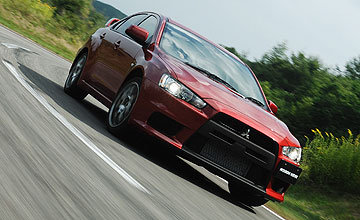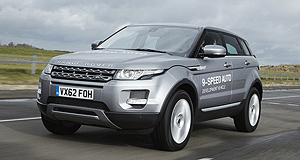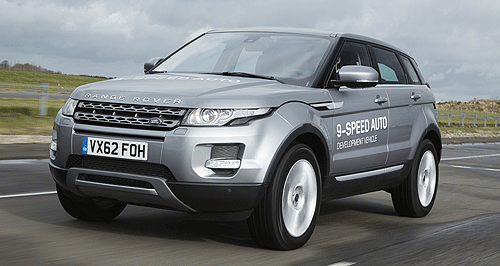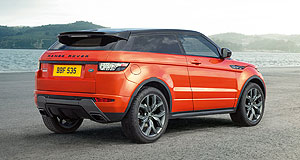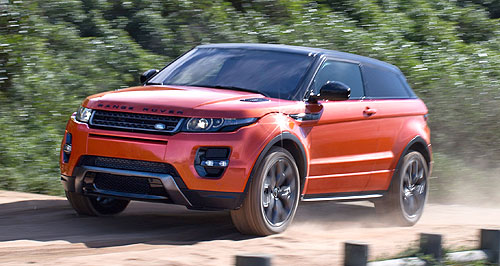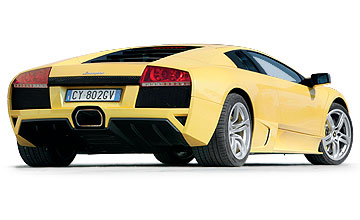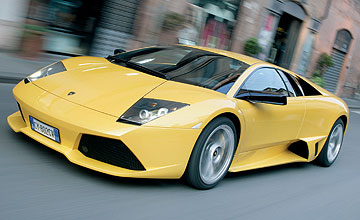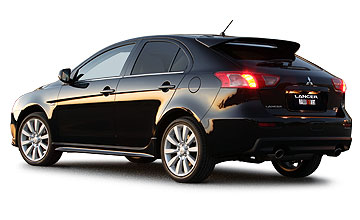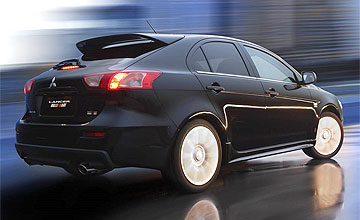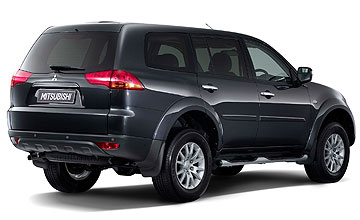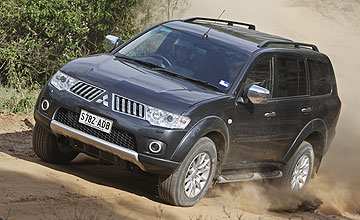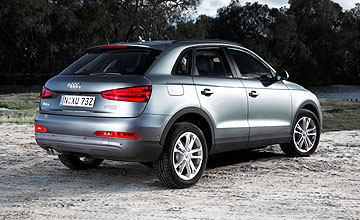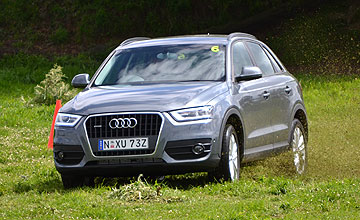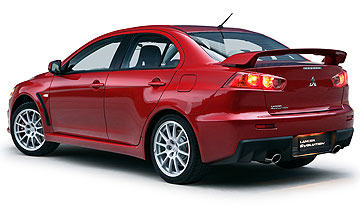
Our opinion
 We like
We like
Awesome traction, stunning handling, improved safety, improved refinement, more safety gear, easier to live with, great value for money
 Room for improvement
Room for improvement
Tyre noise, expensive automatic option, plain interior, extra weight, engine could have a bit more pull, reduced boot space
IN MOTORSPORT, the first rival you have to beat is you teammate. In the case of the Lancer Evo, the first rival it must beat is the Subaru Impreza STi.
So while this is a road test of the Evo, we also took an STi along for the ride.
If you are a rally nut, taking these two precision instruments for a run along a wet and greasy twisting country road is getting about as close to automotive nirvana as you can get.
When you look at the specifications of both cars, it is hard to imagine they would feel very different on the road.
However, the cars are in fact very different and one is significantly better than the other, but we'll get to that later.
Before we get into the details of what the Evo experience entails, we should warn you that despite some improvements and new creature comforts, it is still hard to live with.
This is by no means a surprise or indeed a problem unique to the Evo as the STi is just the same.
While there are other issues such as obscured rear vision (thanks to the wing) and a poor turning circle, the real livability issues sit at each corner of the car.
Tyre roar is remarkably loud and can tend to drive you bonkers if you happen to travel long distances on coarse-chip tarmac. This is a problem shared with the STi, although it is louder on smooth surfaces and not so bad on the coarse-chip tarmac.
Then there is the Evo's suspension, which is best described as stiff. We tested the standard car, which is harsh but reasonable for a sportscar.
It is much more forgiving than the Bilstein shock and Eibach spring set-up that is standard on the range-topping MR and available as an option on the base car.
If you are thinking about going with that suspension, it might be wise to take the car over some fairly harsh bumps when you are test driving it to see if your fillings stay in and whether you can put up with the bump-and-thump ride over the course of your intended ownership period.
From our perspective, unless we were using the car for track work, we'd go for the standard suspension. But if you are prepared to put up with harsh suspension and a fairly loud tyre rumble, the Evo is incredibly rewarding.
On both the road and track, the Mitsubishi is so much better than the person driving it. Its electronic controls as well as its near perfect set-up make its driver look far better than he or she really is.
Whether it be drifting wildly around a corner on the track or rushing along a slippery road at speed but in complete control, the Evo does all the hard work for you.
Even with the standard suspension, the Mitsubishi sits very flat in the turns, with minimal bodyroll even when pressed hard though the bends.
This is not the case with the STi, which has a generally softer set-up. The Subaru pitches and rolls more in the corners, which affects its handling.
That also means it absorbs some of the larger bumps better, but the suspension tune still picks up some of the ruts and lumps on the road and transfers the shocks through to its occupants, resulting in a less comfortable ride than the Mitsubishi.
When it comes to traction, both of these cars are good, but the Evo is better.
On a moist, winding road, the Evo puts its power down with mind-bending ability. To have this level of traction in a car the public can buy (at a not insubstantial price) is truly astonishing.
The Evo's AWD system is constantly shifting its power around from wheel to wheel and axle to axle, but you can't really feel it. It seems a generation ahead of the Subaru system, which can send too much power to the front wheels.
Accelerate hard out of a bend and you can feel the STi tugging at the wheel as it tries to send too much power to the front-end. And you notice it shifting power from the front to the rear.
On the odd bend a heavy vibration comes through the steering wheel, known as rack rattle, which was not evident in the Evo.
When it comes to engine performance, however, the Evo is not perhaps as wild as you might have imagined. In fact, the Mitsubishi's boosted four feels a bit flat, especially when compared to the superior Subaru boxer engine which gives the STi a claimed half-second advantage to 100km/h.
For the record, the official 0-100km/h number for the Subaru is 5.2 seconds, while the Mitsubishi's is 5.7.
In some other markets Evo customers can choose a more potent engine option and it would be nice to have that opportunity here as the Evo is clearly good enough to handle the extra punch.
The Evo's engine is still punchy and very smooth, but it just doesn't quite match the Subaru's venom. A bit more torque to speed things up off the line would be very welcome.
And if you are expecting four-cylinder fuel consumption, you will be rather disappointed. The Evo slurped around 14 litres per 100km on the more spirited parts of the drive and a less frightening 8.5L/100km on the highway.
It has more of a drinking problem than the Subaru, which used around 1.0L/100km less during most of our drive.
The last Evo used a six-speed manual, but this time around it makes do with a five-speed. Has Mitsubishi found that five gears are better than one? No, it says the five-speeder is tougher and can handle more grunt that the six-speed.
It seems Mitsubishi didn't bother to work on a stronger manual box as it was spending more than enough of its cash on the new dual-clutch SST automatic gearbox, which is a ripper.
While the test car was a manual, time on the launch in a dual-clutch automatic version proved it is a great transmission with super-fast shifts and a competent automatic mode.
That said, it costs a whopping $5000 more than the manual. That's a lot of cash for an automatic and while Porsche and BMW charge even more for their dual-clutch automatics, $5000 is a hefty premium on a car of this price.
But you don't have to pick an SST dual-clutch automatic and by merely making it available (even if the price is a bit steep) Mitsubishi has laid a nice upper cut on Subaru's chin which has no automatic transmission available for the STi.
The Evo's interior looks better than the last one, but is still not great. It is clear most of the development money was sent to the white-coats working on the AWD system and other mechanical bits, which is just fine by us.
The interior isn't ugly, but it is plain and there is some cheap looking plastic in here that has a South Korean budget flavour. It is bit nicer in the Subaru, which does a better job with surfaces, although the swooping lines of the dashboard can be visually confronting.
The standard seats in the Evo are very supportive and look great, while its standard wheels also look very cool. In the case of the Subaru, the base car has slightly disappointing seats and the standard wheels don't look the goods.
You can pay an extra $5000 for better seats and nicer wheels, which is a bitter pill when you have already handed over $60,000. In our view, a car this price should have these features as standard.
When it comes to safety, the Evo and the STi are both greatly improved. The last versions of these cars didn't even come with electronic stability control or side airbags - now they have ESC and a suite of six airbags including curtain airbags, which is great news.
Lastly, the question of style must be covered. While this is a truly subjective area, we'll tell you what we think anyway, which is that the STi looks a heap better than the WRX - but so do a lot of other cars.
Its wider stance gives it more menace, but the wimpy rounded front-end spoils the picture. The Evo, on the other hand, looks only slightly less mean than a life member of an outlaw bikie gang.
Its crisp form and chiseled profile give it a far more muscular outline and it is easily recognisable in the rear-view mirror, which usually doesn;t happen for that long.
By now you have probably gathered the Evo is a far more precise instrument than the STi. It may be slightly slower in a straight line, but the world these rally weapons inhabit have corners, lots of them, and that is where the Evo has a clear upper hand.
The Evo is an awesome performance car that deserves to be compared to far more expensive rivals than its traditional sparring partner from Subaru.
